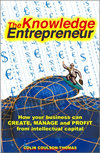 |
 |
|
 |
Creating a Company that can Compete and Win
By Professor
Colin Coulson-Thomas
In many sectors different companies appear to have similar competitive
strategies. They recruit from the same business schools, buy the same
technologies and employ standard processes. Yet some expand and prosper
while others decline. Despite a decade of re-engineering, a succession
of management fads, heavy investment in IT and extensive use of management
consultants many companies struggle to cope. What do the businesses that
adapt and grow do differently?
For more than a decade a research programme led by the author has examined
why some companies win new business, build customer relationships, create
and exploit know-how and manage change while others stagnate. Research
teams compare the approaches and practices of the most and least successful.
They isolate critical success factors for competing and winning. These
are summarised in: ‘Transforming the Company, Manage Change, Compete
and Win’*.
The collective experience of over 2,000 enterprises across many sectors
reveals how profitable and expanding companies become and remain competitive.
People in these businesses don’t print money or cheat. Their attitudes,
approaches, perspectives and priorities ensure they win the battle to
change, re-invent and break free of past constraints.
If you and your colleagues are frustrated and would like to transform
the fortunes of your company you can learn from those who succeed. The
key lessons - and stark differences between winners and losers - can be
expressed in terms of ‘do’s’ and ‘don’ts’.
Let’s start with what you are setting out to achieve. Survival –
getting through the next quarter or twelve months - does not energize
and excite. Be positive. Craft and communicate a distinctive vision, a
compelling purpose, stretching goals and clear objectives.
Remain relevant and stay vital. Develop additional income streams, enhance
capabilities and refresh intellectual capital. Create additional options
and extend choice. Launch new ventures and establish new markets.
Display the will to win. Winners are driven to succeed. Their actions
demonstrate they care. Read the road ahead. Anticipate events and confront
realities. Take a longer-term view and provide strategic leadership. Ensure
immediate priorities do not take precedence over longer-term aims.
Inspire and motivate. Lead and guide. Make sure people understand what
they need to do, are visibly committed, and are prepared, equipped and
enabled to act. Identify and tackle barriers to change. Don’t sidetrack
critics, conceal disappointments or rationalize failure.
However keen you are to go forward don’t make changes for changes
sake. Change can be stressful and it may disrupt valued relationships.
Think before you act. Assess likely consequences. Balance change and continuity.
Distinguish goals, values, objectives, policies and activities that need
to be changed from those that should be continued.
Don’t expend energy in peripheral areas or bark up the wrong trees.
Concentrate your effort where it is most likely to make a difference.
Focus upon the critical success factors for achieving key corporate objectives
and delivering greater customer and shareholder value.
Understand your customers. Ensure they are not disadvantaged by change.
Put yourself out to develop tailored responses. Deliver bespoke offerings
to them. Be proactive. Don’t wait to be asked. Take the initiative.
Identify and approach those you would like to do business with. Push back
the boundaries of what is possible, and aim to become a sought after and
trusted business partners.
Don’t adopt standard approaches or be rigid and inflexible. Think
for yourself rather than imitate and copy others. Jumping upon band-waggons
and ‘me-too’ activities are not the route to market leadership.
Don’t be overly cautious and too wary of commitments. Don’t
respond belatedly to events or fail to anticipate requirements and implications.
Be confident. Don’t be indecisive or oblivious to the needs of others.
Build and release talent. Explore, pioneer and discover. Encourage and
support enterprise and innovation.
Losers are complacent, secretive and defensive. Don’t keep things
to yourself or be reluctant to delegate. Trust other people and share
information and opportunities with them where this is likely to prove
mutually beneficial. Empathise and invite feedback. Question and challenge,
and listen and learn.
Build relationships, but select people, business partners and opportunities
with care. Don’t end up playing other people’s games. At the
same time, don’t focus exclusively upon your own agenda. Collaborate
on the basis of openness and transparency with complementary spirits who
share your vision and values.
Be persistent but pragmatic, and determined but adaptable in pursuit of
your aims. Take calculated risks. Experiment with new ways of working,
learning and collaborating.
The board should help you to compete and win. It should be the heart and
soul of a company, the source of its ambition and drive. Without a sense
of purpose, a sound strategy and the will to achieve, well endowed corporations
wither and die. Whether or not a company achieves and sustains success
depends largely upon the attitudes and conduct of its directors.
Don’t mouth generalizations, engage in spin or confuse activity
with progress. Cut through blather and hype. Get down to the fundamentals
of what needs to be done. Wherever possible adopt simple solutions and
take direct action. Regard change, renewal and transformation as normal
activities.
Don’t try to do everything yourself or resist new and external ideas.
Work with colleagues to foster winning attitudes and behaviours. Balance
strategy with capability and think holistically. Ensure all the pieces
of the jigsaw puzzle required for successful transformation and sustained
competitiveness are in place.
Directors and senior managers cannot become directly involved in the many
and varied activities needed to respond imaginatively to changing circumstances.
Empower business units and venture teams to bring about whatever changes
are required to enable them to achieve their objectives and deliver value
to their customers.
New areas of risk can arise as structures, processes and systems are reviewed
and altered. Make sure people understand what is at stake and are ready
to respond. Problems will arise. Their absence could indicate a lack of
ambition. Learning from them and celebrating success help to sustain momentum.
Finally, go for it. The prospects of ‘loser’ companies can
be transformed by putting the critical success factors required for winning
in place. Achieving success is often easier and is invariably more satisfying
than rationalising failure.
© Colin Coulson-Thomas, 2005

Professor Colin Coulson-Thomas |
About the Author:
Prof. Colin Coulson-Thomas, an experienced company chairman, has
advised over 90 boards and management teams on director, board and
corporate development. Formerly the world’s first Professor
of Corporate Transformation and Process Vision Holder of major transformation
projects, he is the UK’s first Professor of Competitiveness
and can be contacted:
Tel: 01733 361 149
Fax: 01733 361 459
Email: colinct@tiscali.co.uk
Web: www.ntwkfirm.com/colin.coulson-thomas
*‘Transforming the Company, Manage Change, Compete and Win’
by Colin Coulson-Thomas and published by Kogan Page can be ordered
by Tel. 01903 828800; Fax. 020 7837 6348; E-mail: orders@lbsltd.co.uk
or on-line at www.kogan-page.co.uk
or www.ntwkfirm.com/bookshop
|
|
Transforming the Company: Manage Change, Compete & Win
Colin Coulson-Thomas shows that to bridge the gap between rhetoric
and reality, business people must make far-reaching decisions about
the value to them and their companies of particular theories, past
assumptions and traditional approaches. Based on original research,
the first edition of this was ahead of its time and predicted many
of the current management trends. The author now brings the text bang
up-to-date for the 21st century. This second edition of Transforming
The Company shows how to turn theory into practice by highlighting
the obstacles and barriers that confront companies when trying to
bring about change. For management at all levels faced with this task,
this thought-provoking book will inspire and enlighten. |
| 
Buy
UK Buy
US
|
The Knowledge Entrepreneur: How Your Business Can Create,
Manage and Profit from Intellectual Capital
In many companies knowledge management has focused almost exclusively
upon the packaging of existing knowledge. This book is designed
to help readers boost revenues and profit by significantly improving
the performance of existing activities and also creating new offerings
that generate additional income. It shows how practical knowledge-based
job-support tools can transform work group productivity, and reveals
the enormous scope for addressing contemporary problems such as
"information overload" with imaginative responses. Additional
information includes: a list of possible commercial ventures; detailed
checklists that can be used for identifying and analysing opportunities
for knowledge entrepreneurship; and exercises for assessing entrepreneurial
potential and "scoping" possible products and services.
The free CD-ROM packaged with the book gives examples of particular
knowledge-based job support tools that have dramatically improved
desired results in crucial areas such as winning more business.
|

top of page |
 |
